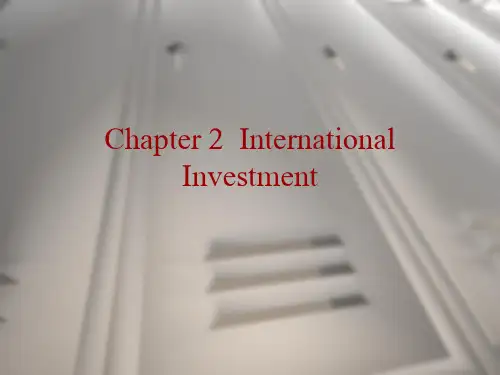世界经济概论(英文版)chapter 01 International Trade
- 格式:pptx
- 大小:1.47 MB
- 文档页数:23
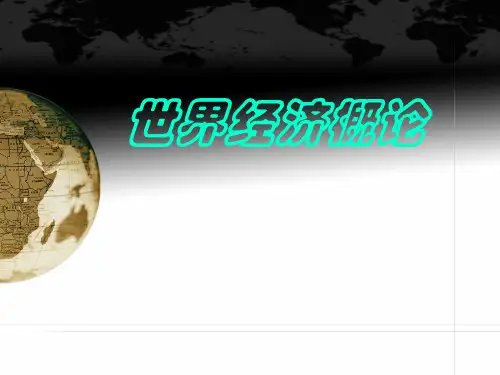
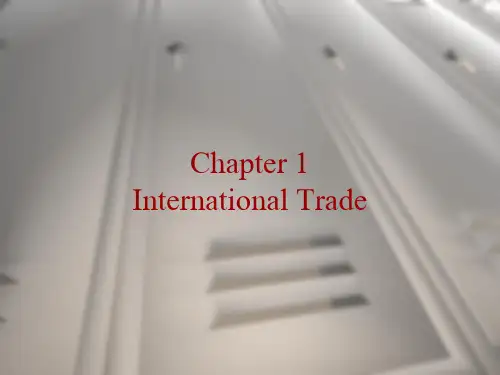
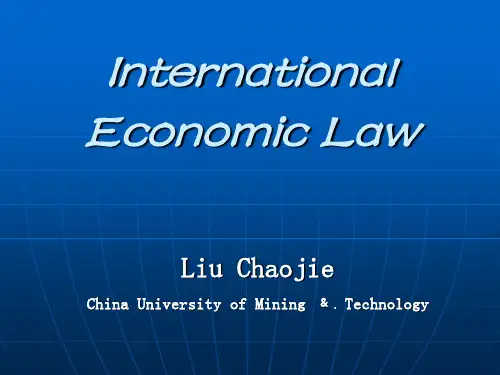
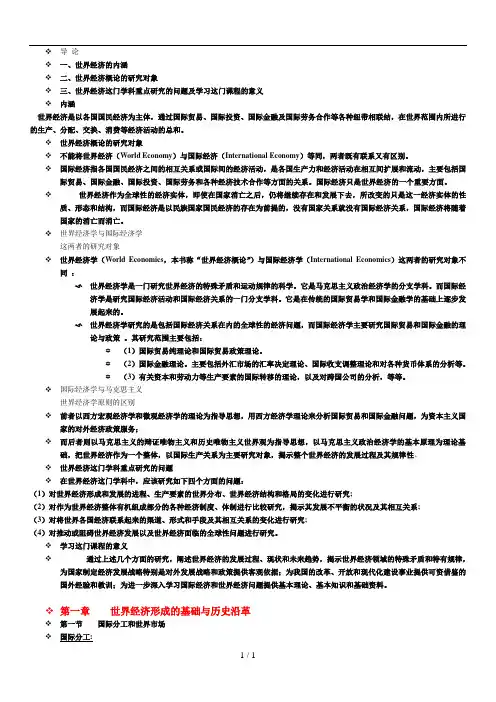
❖导论❖一、世界经济的内涵❖二、世界经济概论的研究对象❖三、世界经济这门学科重点研究的问题及学习这门课程的意义❖内涵世界经济是以各国国民经济为主体,通过国际贸易、国际投资、国际金融及国际劳务合作等各种纽带相联结,在世界范围内所进行的生产、分配、交换、消费等经济活动的总和。
❖世界经济概论的研究对象❖不能将世界经济(World Economy)与国际经济(International Economy)等同,两者既有联系又有区别。
❖国际经济指各国国民经济之间的相互关系或国际间的经济活动,是各国生产力和经济活动在相互间扩展和流动,主要包括国际贸易、国际金融、国际投资、国际劳务和各种经济技术合作等方面的关系。
国际经济只是世界经济的一个重要方面。
❖世界经济作为全球性的经济实体,即使在国家消亡之后,仍将继续存在和发展下去,所改变的只是这一经济实体的性质、形态和结构,而国际经济是以民族国家国民经济的存在为前提的,没有国家关系就没有国际经济关系,国际经济将随着国家的消亡而消亡。
❖世界经济学与国际经济学这两者的研究对象❖世界经济学(World Economics,本书称“世界经济概论”)与国际经济学(International Economics)这两者的研究对象不同:世界经济学是一门研究世界经济的特殊矛盾和运动规律的科学。
它是马克思主义政治经济学的分支学科。
而国际经济学是研究国际经济活动和国际经济关系的一门分支学科。
它是在传统的国际贸易学和国际金融学的基础上逐步发展起来的。
世界经济学研究的是包括国际经济关系在内的全球性的经济问题,而国际经济学主要研究国际贸易和国际金融的理论与政策。
其研究范围主要包括:✡(1)国际贸易纯理论和国际贸易政策理论。
✡(2)国际金融理论。
主要包括外汇市场的汇率决定理论、国际收支调整理论和对各种货币体系的分析等。
✡(3)有关资本和劳动力等生产要素的国际转移的理论,以及对跨国公司的分析,等等。
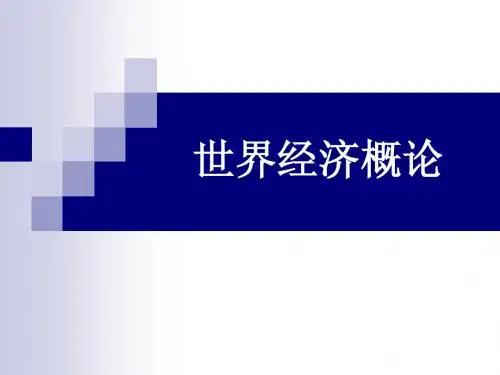
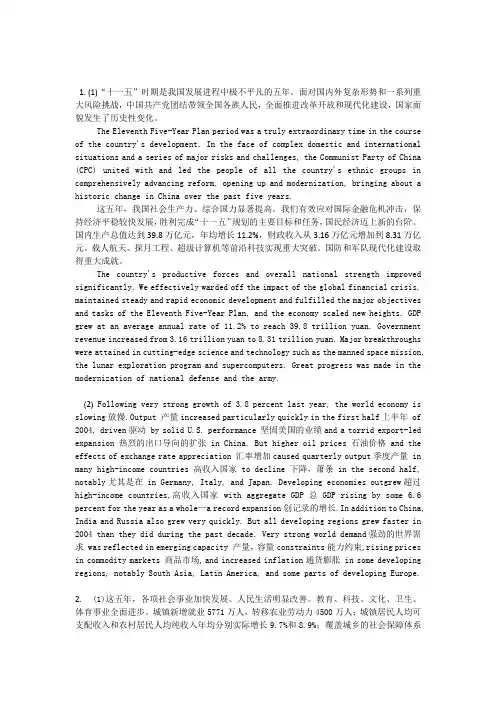
1. (1)“十一五”时期是我国发展进程中极不平凡的五年。
面对国内外复杂形势和一系列重大风险挑战,中国共产党团结带领全国各族人民,全面推进改革开放和现代化建设,国家面貌发生了历史性变化。
The Eleventh Five-Year Plan period was a truly extraordinary time in the course of the country's development. In the face of complex domestic and international situations and a series of major risks and challenges, the Communist Party of China (CPC) united with and led the people of all the country's ethnic groups in comprehensively advancing reform, opening up and modernization, bringing about a historic change in China over the past five years.这五年,我国社会生产力、综合国力显著提高。
我们有效应对国际金融危机冲击,保持经济平稳较快发展,胜利完成“十一五”规划的主要目标和任务,国民经济迈上新的台阶。
国内生产总值达到39.8万亿元,年均增长11.2%,财政收入从3.16万亿元增加到8.31万亿元。
载人航天、探月工程、超级计算机等前沿科技实现重大突破。
国防和军队现代化建设取得重大成就。
The country's productive forces and overall national strength improved significantly. We effectively warded off the impact of the global financial crisis, maintained steady and rapid economic development and fulfilled the major objectives and tasks of the Eleventh Five-Year Plan, and the economy scaled new heights. GDP grew at an average annual rate of 11.2% to reach 39.8 trillion yuan. Government revenue increased from 3.16 trillion yuan to 8.31 trillion yuan. Major breakthroughs were attained in cutting-edge science and technology such as the manned space mission, the lunar exploration program and supercomputers. Great progress was made in the modernization of national defense and the army.(2) Following very strong growth of 3.8 percent last year, the world economy is slowing放慢. Output产量increased particularly quickly in the first half上半年of 2004, driven驱动 by solid U.S. performance坚固美国的业绩and a torrid export-led expansion热烈的出口导向的扩张in China. But higher oil prices石油价格 and the effects of exchange rate appreciation 汇率增加caused quarterly output季度产量 in many high-income countries 高收入国家 to decline下降,萧条in the second half, notably尤其是在in Germany, Italy, and Japan. Developing economies outgrew超过high-income countries,高收入国家 with aggregate GDP总GDP rising by some 6.6 percent for the year as a whole—a record expansion创记录的增长. In addition to China, India and Russia also grew very quickly. But all developing regions grew faster in 2004 than they did during the past decade. Very strong world demand强劲的世界需求 was reflected in emerging capacity产量,容量constraints能力约束,rising prices in commodity markets商品市场, and increased inflation通货膨胀 in some developing regions, notably South Asia, Latin America, and some parts of developing Europe.2. (1)这五年,各项社会事业加快发展、人民生活明显改善。

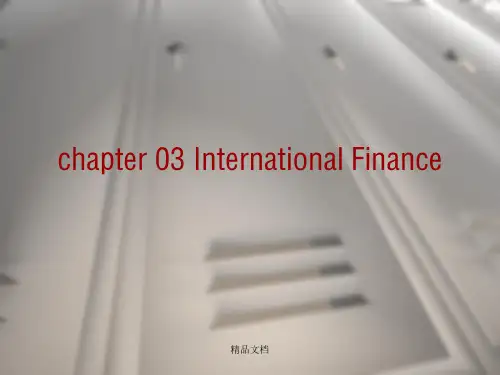

Economics 2: The WorldEconomyReworkContentIntroduction----------------------------------------------------------------3 Section 1: International TradeThree gains from trading internationally---------------------------------------3 Free Trade--------------------------------------------------------------------------3 Absolute and Comparative Advantage-----------------------------------------3 Protectionism----------------------------------------------------------------------4 Barriers to trade-------------------------------------------------------------------4 WTO and EU----------------------------------------------------------------------5 Section 2: International FinanceBalance of Payments and General trends in UK Trade----------------------6 Relationship between the exchange rate and the balance of payments—14 Single Currency------------------------------------------------------------------15 Effects on individuals and business of the Euro-----------------------------15 Section 3: Less Developed Countries (LDCs)Characteristics of a LDC--------------------------------------------------------16 Current issues that face LDCs--------------------------------------------------16 The impacts of multinationals on LDCs and NICs--------------------------16 Conclusion-----------------------------------------------------------------16 References------------------------------------------------------------------17Introduction:As a member of the government of nation on the periphery of Europe, it is my obligation to illustrate the benefits of joining the EU to the Premier. In this report, I will analyze 15elements in next three parts to make a clear explanation of benefits of joining the EU.Section 1: International TradeThree gains from trading internationally:To begin with, the international trade could increase world out-put. The tendency of globalization brings the firms more opportunities to gain the labor, resources, contracts and new technology. The supply and demand will be improved with the improvement of company’s productivity.Once the supply has been improved, the goods and services were produced at lower cost and there are more and more competitions, the price of the product might fall which means consumers could get more choices and cheaper goods.In addition, the most important gaining of international trade is it can generate economic growth. Free trade could increase sales, profit margins, and market shares and the both demand and supply level has updated. Meanwhile, the producer needs more resources, labor and capital to produce more to satisfy the global market. It direct result in improving the material market, finance market, and may decline the unemployment rate.Free tradeFree trade is a concept that there is no barrier to goods and services exchanged between countries. Since different countries have different terrain, weather, resources and technology, the international trade would bring the goods which are more valuable than the local people produce it by themselves.A good example for free trade is in Nov.18, 2004, Chinese President and Chilean President declared the start of the FTA negotiations. According to the agreement, the two countries would start tariff reduction of goods trade from July 1, 2006. Tariff of products accounting for 97% of the total of the two countries would be zero in ten years. China and Chile would carry out free trade in education, science & technology, environment protection, labor, social security, IPR, investment and promotion, mineral and industry. This agreement has promoted the free trade between China and Chile successfully.Absolute and comparative advantageAbsolute advantage refers to the ability of a particular person or a country to produce a particular good with fewer resources than another person or country. Absolute advantage is said to occur when one country can produce a good or service topre-determined quality more cheaply than anther country. It stands contrasted with the concept of comparative advantage which refers to the ability to produce a particular good at a lower opportunity cost. Opportunity cost is defined as the cost of choosing a good or service measured in terms of the next best alternative given up. A country has a comparative advantage in producing a good if the opportunity cost of producing that good in term of other goods is lower in that country than it is in other countries. Example: Korea and Japan have following production possibilities for two commodities, mobile phones and computers; assume that all the resources owned bythe advantage it has is much greater for mobiles. Using the same resources as Korea it can make twice as many mobile phones.For Japan the ‘cost’ of 1 Mobile phone is 10 bales of Computers, i.e. 20000/2000For Korea it is 15, i.e. 15000/1000But if we look at the case of computers we will find that here for Japan the cost of a bale of computers is one-tenth of a Mobile phone while for Korea it is one fifteenth. In terms of the output of Mobile phone foregone (opportunity cost), computer is cheaper in Korea than Japan. Korea has a Comparative advantage in computer while Japan has comparative advantage in mobile phone.ProtectionismProtectionism is the economic policy of restraining trade between nations, through methods such as high tariffs on imported goods, restrictive quotas, a variety of restrictive government regulations designed to discourage imports and anti-dumping laws in an attempt to protect domestic industries in a particular nation from foreign take-over or competition.Here are two examples of protectionism:1: Britain imports bananas from its ex-colonies in South America while USA owns huge banana plantations in South America. In 1999 Britain refused to import bananas from South America, so the US government slapped tariffs on some British-made goods. The most serious one was a punitive tariff of 100% on Scottish wool products in order to limit the import from Britain.2: Another example of protectionism is in January, 2009, American government settled a policy that only the American steel can be used in America. The American government tended to use this policy to reduce the loss in financial crisis and it helps the steel workers to keep their jobs. In this example, protectionism protects the domestic lower-skilled labor and domestic industries.Barriers to tradeTo protect a country’s own industries, the country which in adverse side need to find some ways to be barriers to limit the import products, usually, the two methodsare—tariff and non tariffs.Tariff is taxes or customs duties placed on foreign products to artificially raise their prices and this hopefully, suppresses domestic demand for them. This tax may be ad value, that is, a percentage of the price of the goods or specific, that is, a tax per unit of weight or physical quantity.For example, in January 12, 2009 the Russian government raised the expropriation tariff (up to 30 percent) for the cars import in the next nine months. The import car’s price will be increased to be WP (price for the whole world) adds the tariff, since the price is increasing, the sales of the import cars must fall down. The customers might choose the Russian car instead of import cars since it is cheaper.Non-tariff barriers traditionally have been actions such Quotas, embargoes, exchange control and import deposits. Probably the best known of these is the quota. This is a physical limitation on the quantity of import. Quota is a physical limitation on the quantity of imports which had been acknowledged by local laws. Usually the importers need to apply to pay for a license to sell goods.For instance, Russia uses another method to limit foreign car import since 2008—to limit the quantity of import; only a few companies which have the import license could import cars and have a selling upper limit. Russia uses these methods to restrict the import quantity, and during the government limited foreign goods import, it can promote the domestic industries.WTO and EUIn 1948, the General Agreement on Tariffs and Trade (GATT) was established by the developed countries. In 1 Jan 1995, the GATT was supplanted by a new institution, the World Trade Organization (WTO) and aims to improve trade and investment flows around the world. It is an international body seeking to promote free trade by opening markets through the elimination of import tariffs. The organization administers trade agreements, monitors international trade policy and acts as a forum for trade negotiations. The four main goals of WTO are: freeing global trade through universally lowered tariffs, imposing the same rules on all members in order to homogenize the trade process, spurring competition through lowered subsidies, and ensuring the same trade concessions for all member nations. The WTO also provides technical assistance and training for developing countries. WTO aims for equal representation among members by granting each member country "most-favored nation" status; when a member country bestows a trade privilege on another nation, the privilege must be extended to all other member countries. Another tenet is "national treatment," which behooves countries to treat foreign imports equally with those produced domestically.The best example for joining the WTO is the join of China in 2007, after that, China achieves lots of benefits from the decrease of tariff, limitations and the simplification of trading procedures.EU stands for European Union and is an economic union, which aims to abolish tariffs and quotas among members, common tariff and quota system, restrictions onfactor movements and harmonization and unification of economic policies and institutions. It draws out regulations, monitors member states, solves disputes and problems among member states and negotiates with other countries or international organizations on the behalf of EU members. The European Union aims to promote and smooth free trade among internal European Union and initiatives for simplifying national and community rules include simpler legislation for the internal market (SLIM) and European Business Test Panel. For example, in Oct 16, 2009, EU and Korean government signed a free trade agreement of 100 billion US dollars after two years’ negotiation and EU will cancel the tariffs on imports of textile and cars from Korea in the next three years. This will promote the free trade of EU and have positive impact on the economy.Section 2: International FinanceBalance of Payments and General trends in UK TradeBalance of payment is the name given to the record of transactions between the residents of the country and the rest of the world over a period of time. It is a key economic statistics and UK’s Balance of Payments is comprises by the current account, the capital account, the financial account which deals with flow of direct portfolio and investments and reserve assets and the International Investment Position which shows the Stock of External Financial Assets and Liabilities. The chart below shows the composition if Balance of Payments in 2008:a) The current account can be divided into four categories: trade in goods, trade in service, income and current transfers. Positive net income from abroad corresponds to a current account surplus; negative net income from abroad corresponds to a current account deficit.Here are the trade figures of recent years:Here are the Current Account Balance Chart and the Chart of trade in Goods and services of UK in last 20 years.The current balance has usually been in deficit over the last 30 years.The UK has recorded a current account deficit in every year since 1984. Prior to 1984, the current account recorded a surplus in 1980 to 1983. From 1984 to 1989, the current account deficit increased steadily to reach a high of 25.5 billion pounds in 1989, equivalent to -4.9 per cent of Gross Domestic Product (GDP). From 1990 until 1997, the current account deficit declined to a low of 1.0 billion pounds in 1997. Between 1998 and 2006, the current account deficit widened sharply, peaking at 43.8 billion pounds in 2006. This was the highest recorded in cash terms but only equated to -3.3 per cent of GDP. In the past two years, there has been a reduction in the current account deficit –in 2008 it currently stands at 25.1 billion, equivalent to -1.7 per cent of GDP.It is obvious that UK had a large deficit in trade of goods in the last 30 years and the deficit becomes lager and increases greatly from 1998 to 2008 while the surplus of trade in service grows smoothly but not as markedly as the goods deficit. The trade in goods account recorded net surpluses in the years 1980 to 1982, largely as a result of growth in exports of North Sea oil. Since then however, the trade in goods account has remained in deficit. The deficit grew significantly in the late 1980s to reach a peak of 24.7 billion in 1989, before narrowing in the 1990s to levels of around 10 billion to 14 billion. In 1998 the deficit jumped by over 9 billion, and it has continued to rise since, reaching a cash record of 92.9 billion in 2008.There are two different of Income—Direct Investment Income and Portfolio Investment Income. The Direct Investment Income means the profits earned by UK companies from overseas branches and associated company. And the Portfolio Investment Income is the interest on bonds and dividends, held abroad by UK companies and residents.Here are charts of income over the 10 years:The income section has shown positive growth from 2006 to 2008 and is very much in surplus recently.As for the current transfer, it also has two different parts:The taxes, payments and receipts to the EU, Social Security Payments abroad, and military expenditure abroad is the Central Government Transfer. And for Other Sector Transfers, it includes receipts from the EU Social Fund, taxes on income and wealth paid by UK workers and businesses to foreign governments, insurance premiums and claims.There is the Chart of Current transfer in last 10 yearsThe transfers account has shown a deficit in every year since 1960. The deficit increased steadily to reach 4.8 billion in 1990. In 1991, the deficit reduced to 1.0 billion, reflecting 2.1 billion receipts from other countries towards the UK’s cost of the first Gulf conflict. The deficit has since increased, to reach a record 13.6 billion in 2008.b) Compared with Current Accounts, the composition of the Capital and Financial Account is more complicate.Capital Account has two categories:Capital transfer: It is investment grants by the government and debts which the government has agreed with the creditor do not need to be met.Acquisition and disposal of non produced/nonfinancial assets: Purchase or sales of property by foreign embassy or patents, copyrights, trademarks, franchises and leases.The capital account has shown strong steady surplus growth especially from the year of 2006 to 2008.The financial account has four categories and here are the charts of the four categories over the last ten years:According to these graphs, investment increased dramatically from the mid-1990s, reflecting the increased globalization of the world economy. Between 2000 and 2007, other investment dominated cross-border investment, primarily banking activity. In 2008 however, other investment, has recorded net disinvestment as the global financial crisis deepened leading to a reduction in loans internationally and a repatriation of deposits. In recent years, including the latest, the UK has needed to borrow from abroad to finance a continuing current account deficit, which has resulted in inward investment (UK liabilities) exceeding outward investment (UK assets).c) The international investment position is the balance sheet of the stock of external assets and liabilities. Between 1966 and 1994 the UK’s assets tended to exceed itsliabilities, by up to a record 86.4 billion pounds in 1986. But from 1995 to 2007, the UK recorded a net liability position in every year, reaching a record 352.6 billion pounds in 2006. In 2008, the UK returned to a net asset position of 92.9 billion pounds mainly due to exchange rate effects.The chart below indicates UK’s international investment position:Relationship between the exchange rate and the balance of paymentsThe exchange rate is the price of a currency in terms of other currencies. Its effect on balance of payments will depend upon its relationship with other currencies and how its value will change. As the currency weakens (devalues) the exports will become cheaper abroad but the country has to pay more for imports but the goods and services would become internationally cheaper and lead to more goods a services being purchased. If demand remains the same then the value of goods and services to the country will reduce and the current account balance may deteriorate. If the exchange rate rises then the country’s goods and services might suffer and demand from abroad could fall. If the demand remains the same however then the value of exports will rise and the current account balance should improve.For instance, when the UK market needs to import American goods (such as corns) the exchange market in UK would be the demand of U.S dollars is larger than the supply of UK pounds. If the American markets needs import more British goods, they need to exchange more pounds in the currency market, so the both of demand of US Dollar and supply of UK Pounds is increasing, meanwhile, the exchange rate of £/$is increasing. UK pound is more valuable means the goods of UK are usually more expensive and American people need to spend more US dollars compared to thesame amount of pounds. That is why the currency exchange rate is so important for the balance of payments. For example, if the exchange rate of £/$is increasing, the American business man might not choose UK goods, because of the high price. Single CurrencyEuropean single currency Euro came to exist since 1999. There are 12 member states of EU who use Euro while UK is still not one of the members since there are both advantages and disadvantages to join it.Advantages:At firstly, the single currency reduces the exchange rate uncertainty because people don't have to convert money from one currency to another when purchase goods. Meanwhile, using the single currency will increase foreign investment such as direct inward investment since the reduction of uncertainty. Then it may produce a great transparency. Whether people buy or sell goods, consumers can compare price in a single currency. It will help to decrease the scope for price discriminations and create pressure to lower the price. Moreover, it could maintain interest rate lower and the commitment to low inflation should allow economies to operate with lower cost. Disadvantages:A country may lose the independent monetary policy if it joins the single currency. The single currency forces a country to forgo an independent monetary policy. After the single currency has been used, the country's monetary policy will determined by the supranational central bank and not by the domestic central bank. This is why the theory of optimal currency areas emphasizes the importance of flexible prices, labor mobility and fiscal transfers. Flexible prices and labor mobility become more important when a currency union exists; governments have an incentive to make markets work more efficiently.Besides, there are also political costs to the country. If the government loses control over monetary policy to the supranational central bank, politicians are limited to using fiscal policy to influence economy.Effects on individuals and business of the EuroAs for the individuals,they can get lower prices and higher quality goods and services when they have more choices due to increased competition among companies through the Euro zones; they can measure the good price through Europe and choose the best one. In addition, single currency reduces the transaction costs of traveling in Europe. Individuals could travel more frequently than past since it is more convenient and cheaper. People do not need to concern the exchange rate and commission fee when visiting the other countries in Europe.As for the business, people could avoid the exchange rate risk and traders do not need to waste time and cost on purchasing foreign currencies. Moreover, the business market could be expanded there are more opportunities.Section 3: Less Developed Countries (LDCs) Characteristics of a LDCLess Developed Countries (LDCs) mainly exist in Asia and Africa. Most LDCs’subsistence is agriculture. The land of LDCs is very ineffectively used and is very low in productivity, there are normally no modern techniques or equipment available, and the land is always threatened by floods or droughts. The birth rates in LDCs are very high but there is very heavy infant mortality since the health care system is poor.A good example for LDC is Angola. A 2007 survey concluded that low and deficient niacin status was common in Angola. Many regions in this country have high incidence rates of tuberculosis and high HIV prevalence rates. Angola has one of the highest infant mortality rates in the world and one of the world's lowest life expectancies.Current issues that face LDCsThe World Bank offers aid programs to Angola to support the health care system of Angola to reduce the infections of HIV but the aid programs they get from the World Bank of IMF carry conditions which they feel are difficult to comply with, and are expensive.Besides, the indebtedness of Angola keeps increasing year on year. This makes Angola almost impossible to borrow more.They borrow a huge amount of money to develop their economy, purchase foreign goods and service. However, the high interest or other factors make debts become a great stress on LDCs. They are in the trip of debts, which prevent the development of their economy.The impacts of multinationals on LDCs and NICsNow days, there are more and more multi-national firms which have branches in various countries since it can reduce the labor, material, transport cost. Companies from newly industrialized countries tend to be MNCs. A good example for multinationals on NICs and LDCs is Great Wall Computer Corporation from China. This company invests 120 million dollars to build a new factory in Algeria to expand its market and increase 34 percent of its foreign sale income. The company offers more jobs to the people in Algeria thus increase the employment and income of Algerian. The company also brings new technology to this less developed country. However, the company transfers most of profits back to China and uses their financial strength to impose their will in host counties either.ConclusionAfter analyzing these 15 elements, you may have a clear acknowledge of the international trade, finance and LDCs and as for the economic environment of the whole area, it can be benefit to join the EU. It will enhance our country’s economic growth by attracting more free capital, using single currency and enlarge the market.References:Web research:/downloads/theme_economy/PB09.pdfRelated Web sites /wiki/Protectionism/eurocash.asp/Book resource:The Economics 2: The World Economy: Higher National Diploma. Scottish Qualifications AuthorityUnited Kingdom Balance of Payments the Pink Book 2009: Office for National Statistics。
